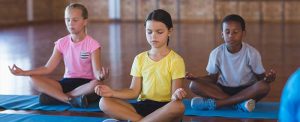Enhance Spatial Cognition in Younger Children with Movement Meditation and Creativity with Sitting Meditation in Older Children
By John M. de Castro, Ph.D.
“mindfulness as a powerful new skill to offer students, not just to manage stress but also to keep them from acting out. Its appeal: one simple, centralized intervention with effects that potentially stretch beyond the classroom.” – Brian Resnick
Childhood is a miraculous period during which the child is dynamically absorbing information from every aspect of its environment. This is particularly evident during the elementary school years. Mindfulness training in school has been shown to have very positive effects. These include improvements in the academic, cognitive, psychological, and social domains. Training early in childhood has the potential of jump-starting the child’s academic performance. It is not known, however, what form of meditation training works best for children of different ages.
In today’s Research News article “Age-Related Differential Effects of School-Based Sitting and Movement Meditation on Creativity and Spatial Cognition: A Pilot Study.” (See summary below or view the full text of the study at: https://www.ncbi.nlm.nih.gov/pmc/articles/PMC8303844/ ) Marson and colleagues recruited children 10 to 13 years of age in the 5th through 8th grades and had them perform two practices in counterbalanced order for 10 weeks; a 5-minute sensorimotor task (mindful movements) and a 5-monute sitting meditation (Open monitoring). Before and after each training the children were measured for cognitive performance with a hidden figures test and for creativity with an alternative uses test.
They found that the younger children were most affected by the meditative movement training while the older children were affected more by the sitting meditation, In particular, younger children had significant increases in spatial cognition (hidden figures task), and the number of uses (fluency) and the number of categories of uses (flexibility) in the alternative uses task after meditative movement training. On the other hand, the older children had significantly greater improvements in creativity (unusual, divergent uses in the alternative uses task) after the sitting meditation.
Hence, meditative movement training improved younger children’s’ spatial cognition, fluency, and flexibility while sitting meditation improved older children’s creativity. These are interesting findings that suggest that different kinds of mindfulness trainings are most effective at different ages of children. Movement based training are most effective with younger children while sitting meditation id most effective with older children. It has been shown that mindfulness training has many benefits for children. In the present study, the benefits involve improvements in spatial cognition and creativity. The present research suggests that the type of training that is most effective is age dependent.
So, enhance spatial cognition in younger children with movement meditation and creativity with sitting meditation in older children.
“The simple act of teaching children how to stop, focus, and just breathe could be one of the greatest gifts you give them.” – Healthy Children
CMCS – Center for Mindfulness and Contemplative Studies
This and other Contemplative Studies posts are also available on Google+ https://plus.google.com/106784388191201299496/posts and on Twitter @MindfulResearch
Study Summary
Marson, F., Fano, A., Pellegrino, M., Pesce, C., Glicksohn, J., & Ben-Soussan, T. D. (2021). Age-Related Differential Effects of School-Based Sitting and Movement Meditation on Creativity and Spatial Cognition: A Pilot Study. Children (Basel, Switzerland), 8(7), 583. https://doi.org/10.3390/children8070583
Abstract
Psychophysical well-being can be supported during development by the integration of extra-curricular activities in scholastic settings. These activities can be implemented in different forms, ranging from physical activities to sitting meditation practices. Considering that both such activities are thought to affect children’s psychophysical development, a movement-based meditation that combines the two approaches−in the form of a short daily activity−could represent a powerful tool to promote healthy physical and mental development. Consequently, the current pilot study aimed to examine the effect of short daily school-based sitting and movement meditation trainings on creativity and spatial cognition. Utilizing a crossover design, we evaluated their feasibility and efficacy at different ages among children (n = 50) in 5th to 8th grade. We observed that 5 weeks of daily training in sitting and movement meditation techniques improved children’s cognition differently. Specifically, younger children showed greater creativity and better spatial cognition following the movement-based meditation, while older children showed greater enhancement in these areas following sitting meditation training. This suggests that training can affect children’s cognition differently depending on their developmental stage. We discuss these results within the framework of embodied and grounded cognition theories. Information on feasibility and age-related effect sizes derived from the current study paves the way for future well-powered larger-scale efficacy studies on different forms of school-based interventions to cognitive development promotion.
https://www.ncbi.nlm.nih.gov/pmc/articles/PMC8303844/
